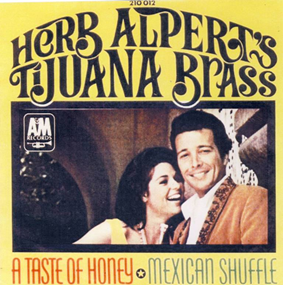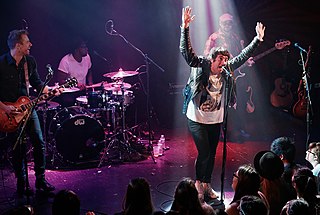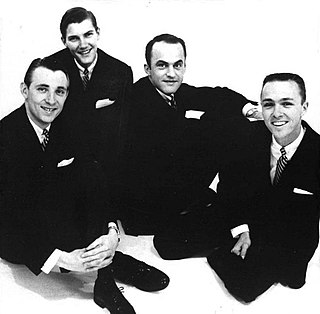
The Righteous Brothers are an American musical duo originally formed by Bill Medley and Bobby Hatfield but now comprising Medley and Bucky Heard. Medley formed the group with Hatfield in 1963. They had first performed together in 1962 in the Los Angeles area as part of a five-member group called the Paramours, and adopted the name The Righteous Brothers when they became a duo. Their most active recording period was in the 1960s and '70s, and, after several years inactive as a duo, Hatfield and Medley reunited in 1981 and continued to perform until Hatfield's death in 2003. The music they performed is sometimes dubbed "blue-eyed soul".

The Seekers were an Australian folk-influenced pop group originally formed in Melbourne in 1962. They were the first Australian pop music group to achieve major chart and sales success in the United Kingdom and the United States. They were especially popular during the 1960s, with their best-known configuration of Judith Durham on vocals, piano and tambourine; Athol Guy on double bass and vocals; Keith Potger on twelve-string guitar, banjo and vocals; and Bruce Woodley on guitar, mandolin, banjo and vocals.

Gladys Knight & the Pips were an American R&B, soul and funk family music group from Atlanta, Georgia, that remained active on the music charts and performing circuit for over three decades starting from the early 1950s.

Bruce & Terry was an American rock music duo from Los Angeles that was active from 1963 to 1965. Consisting of Columbia Records staff producers Bruce Johnston and Terry Melcher, the pair recorded under a variety of names, and most notably with the band the Rip Chords. After 1965, Johnston and Melcher reduced their collaborations together, but both producers continued to occasionally contribute to tracks by the Beach Boys, including on the albums Pet Sounds (1966), Still Cruisin' (1989), and Summer in Paradise (1992).

Percy Faith was a Canadian-American bandleader, orchestrator, composer and conductor, known for his lush arrangements of instrumental ballads and Christmas standards. He is often credited with popularizing the "easy listening" or "mood music" format. He became a staple of American popular music in the 1950s and continued well into the 1960s. Though his professional orchestra-leading career began at the height of the Swing Era, he refined and rethought orchestration techniques, including use of large string sections, to soften and fill out the brass-dominated popular music of the 1940s.

Louis Allen Rawls was an American bass-baritone singer, record producer, composer and actor. Rawls released 61 albums, sold more than 40 million records, and had numerous charting singles, most notably the song "You'll Never Find Another Love like Mine". He also worked as a film, television and voice actor. He was a three-time winner of the Best Male R&B Vocal Performance Grammy Award.

Eydie Gormé was an American singer who had hits on the pop and Latin pop charts. She sang solo and in the duo Steve and Eydie with her husband, Steve Lawrence, on albums and television. She also performed on Broadway and in Las Vegas.

Maurice White was an American singer, musician, songwriter, bandleader, and record producer. He was best known as the founder, leader, main songwriter and chief producer of the band Earth, Wind & Fire, also serving as the band's co-lead singer with Philip Bailey.

The Lettermen are an American male pop vocal trio whose trademark is close-harmony pop songs with light arrangements. The group started in 1959. They have had two Top 10 singles, 16 Top 10 singles on the Adult Contemporary chart, 32 consecutive Billboard chart albums, 11 gold records, and five Grammy nominations.

"A Taste of Honey" is a pop standard written by Bobby Scott and Ric Marlow. It was originally an instrumental track written for the 1960 Broadway version of the 1958 British play A Taste of Honey. Both the original and a later recording by Herb Alpert in 1965 earned the song four Grammy Awards.

The Plain White T's are an American rock band from Lombard, Illinois, formed in 1997 by high school friends Tom Higgenson, Dave Tirio, and Ken Fletcher, and joined a short time later by Steve Mast. The group had a mostly underground following in Chicago basements, clubs, and bars in its early years.

The Singers Unlimited was a four-part jazz vocal group formed by Gene Puerling in 1971. The group included Len Dresslar, Bonnie Herman, and Don Shelton.

The Hi-Lo's were a vocal quartet formed in 1953, who achieved their greatest fame in the late 1950s and 1960s. The group's name is a reference to their extreme vocal and physical ranges.
Lambert, Hendricks & Ross were an American vocalese trio formed by jazz vocalists Dave Lambert, Jon Hendricks and Annie Ross. From 1962 to 1964, Ross was replaced by vocalist Yolande Bavan.

Ruby & the Romantics was an Akron, Ohio-based American R&B group in the 1960s, composed of Ruby Nash, George Lee, Ronald Mosely, Leroy Fann and Ed Roberts.

The Barbra Streisand Album is the debut album by American singer Barbra Streisand, released February 25, 1963, on Columbia Records, catalogue CL 2007 in mono and CS 8807 in stereo. It peaked at number 8 on the Billboard Top LPs, and has been certified a gold album by the RIAA. By 1966, the album had sold over one million copies worldwide.

Anita Jean Kerr was an American singer, arranger, composer, conductor, pianist, and music producer. She recorded and performed with her vocal harmony groups in Nashville, Los Angeles, and Europe.
"I Get Along Without You Very Well" is a popular song composed by Hoagy Carmichael in 1939, with lyrics based on a poem written by Jane Brown Thompson
Robert William Scott was an American musician, record producer, and songwriter.
The Rip Chords were an early-1960s American vocal group, originally known as the Opposites, composed of Ernie Bringas and Phil Stewart. The group eventually expanded into four primary voices, adding Columbia producer Terry Melcher and co-producer Bruce Johnston. This group came to be associated with the hot-rod and surf genres of that day, although their first single did not reflect those styles. They recorded for Columbia Records in Hollywood from 1962 to 1965. The group placed five singles on the Billboard Hot 100. They are best known for their number-four single: "Hey Little Cobra".
















